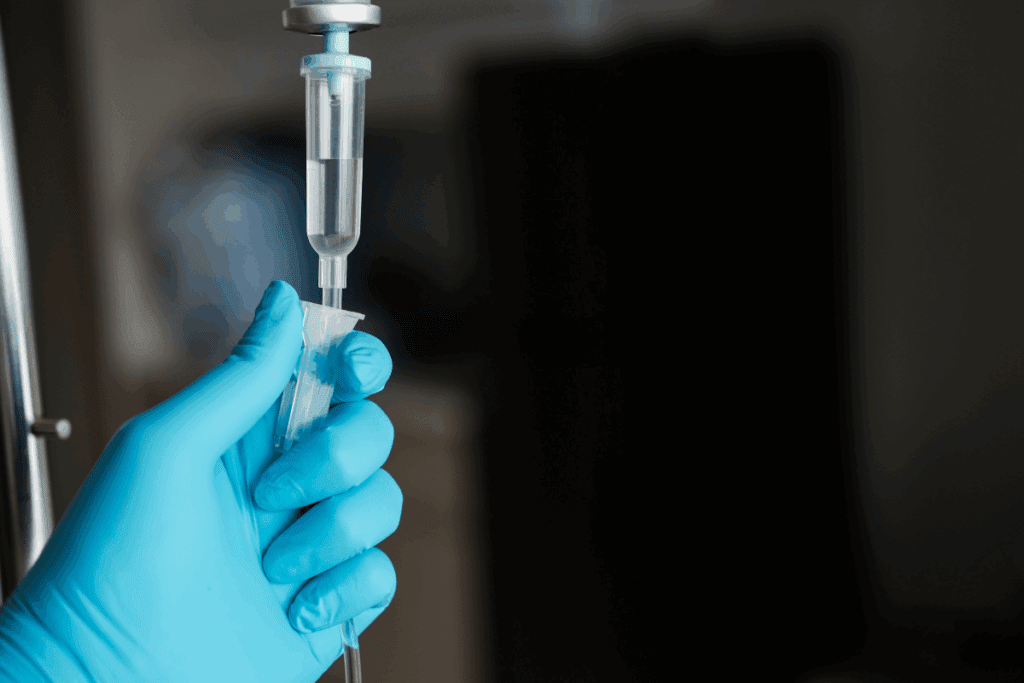Last Updated on November 25, 2025 by Ugurkan Demir

Understanding and managing bladder cancer treatment is key for patients. At Liv Hospital, we offer full care and support. We use the latest medical tech to help patients get better.
Chemotherapy is a main part of treating bladder cancer. It uses drugs to kill cancer cells. In the U.S., about 84,000 new cases happen each year. Our team works hard to support patients with compassionate and personalized care.
Understand bladder chemotherapy and learn how to manage treatment effectively for bladder cancer.

It’s important to know about bladder cancer to choose the right treatment. Bladder cancer is not just one disease. It has different types and stages, each needing its own treatment plan.
Bladder cancer is divided into two main types: NMIBC and MIBC. NMIBC stays in the bladder lining and often comes back. But, it’s less likely to grow deeper. MIBC goes deeper into the bladder and can spread to other parts of the body.
The stage of bladder cancer is key for treatment choices. Staging shows how far the cancer has spread. This helps decide if surgery, chemotherapy, or a mix of treatments is best.
Treatment for bladder cancer varies based on the cancer’s type, stage, and grade. It also depends on the patient’s health. Early-stage NMIBC might get intravesical therapy. More advanced cases might need surgery to remove the bladder. Chemotherapy is important in treating bladder cancer, helping prevent it from coming back after surgery or treating it if it has spread.
For MIBC, neoadjuvant chemotherapy is often used before surgery. It makes the tumor smaller, making surgery easier. Adjuvant chemotherapy is used after surgery to kill any cancer cells left behind, lowering the chance of it coming back.
Chemotherapy is a key part of treating bladder cancer, mainly for advanced or muscle-invasive cases. The choice of bladder cancer chemotherapy drugs depends on the disease stage, patient health, and past treatments. Drugs like cisplatin, gemcitabine, and MVAC are commonly used.
Adding chemotherapy to treatment plans can greatly improve patient outcomes. Knowing how chemotherapy works in bladder cancer treatment helps patients make better choices about their care.

To understand how chemotherapy helps with bladder cancer, we need to look at the science. Chemotherapy is a key part of cancer treatment. It helps lower the chance of cancer coming back and can improve survival rates.
Drugs like cisplatin and gemcitabine target fast-growing cancer cells. They mess with the DNA of these cells, stopping them from growing and leading to their death. Knowing how these drugs work helps us see why chemotherapy is so important in treating bladder cancer.
Chemotherapy can be given in different ways, depending on the cancer’s stage and type. Systemic chemotherapy sends drugs through the blood to fight cancer all over the body. On the other hand, intravesical chemotherapy puts drugs right into the bladder. This method focuses the treatment on the bladder lining where the cancer is.
| Administration Method | Description | Use in Bladder Cancer |
| Systemic Chemotherapy | Drugs delivered through the bloodstream | Used for cancer that has spread beyond the bladder |
| Intravesical Chemotherapy | Drugs instilled directly into the bladder | Used for early-stage bladder cancer or to prevent recurrence |
Doctors recommend chemotherapy based on the cancer’s stage and type. For early bladder cancer, intravesical chemotherapy might be used to stop it from coming back. For more advanced cases, systemic chemotherapy is used to treat cancer that has spread.
Understanding the science behind bladder chemotherapy helps patients know their treatment options. It shows how chemotherapy can help manage bladder cancer.
Bladder cancer chemotherapy uses many drugs, each with its own way of working. It’s important for patients to know about these drugs. This helps them understand their treatment better and make informed choices.
Cisplatin is a key drug for treating bladder cancer, mainly for advanced cases. It stops cancer cells from making copies by messing with their DNA. Other drugs like carboplatin and oxaliplatin are also used, often with other treatments.
Benefits of Platinum-Based Agents:
Gemcitabine is another drug used for bladder cancer. It stops cancer cells from copying themselves by blocking DNA synthesis. It’s often paired with cisplatin for advanced bladder cancer treatment.
Key Features of Gemcitabine:
MVAC (Methotrexate, Vinblastine, Adriamycin, and Cisplatin) is a mix of drugs for bladder cancer. It uses several drugs to attack cancer cells more effectively. Researchers are also looking into other mixtures to improve treatment results.
| Chemotherapy Regimen | Drugs Used | Primary Use |
| MVAC | Methotrexate, Vinblastine, Adriamycin, Cisplatin | Advanced Bladder Cancer |
| Gemcitabine + Cisplatin | Gemcitabine, Cisplatin | Advanced or Metastatic Bladder Cancer |
Knowing about the different drugs and treatments helps patients make better choices. They can work with their healthcare team to get the best results.
Neoadjuvant chemotherapy is a treatment given before surgery for bladder cancer. It aims to shrink tumors and kill cancer cells that have spread. This method is key in treating bladder cancer effectively.
The main goal of neoadjuvant chemotherapy is to make surgery more successful. It does this by reducing tumor size and killing cancer cells that have spread. This can greatly improve surgery outcomes and lower the chance of cancer coming back.
Key benefits of neoadjuvant chemotherapy include:
Neoadjuvant chemotherapy for bladder cancer involves a mix of drugs given over several cycles before surgery. The specific treatment plan depends on the patient’s health, cancer stage, and other factors.
A common treatment includes cisplatin-based chemotherapy, given every 3-4 weeks. The treatment lasts from 3 to 6 months, followed by recovery before surgery.
Neoadjuvant chemotherapy not only shrinks tumors but also prepares the body for surgery. It improves the patient’s condition, making them stronger during surgery.
It’s important for patients to talk openly with their healthcare team during treatment. They should report any side effects or concerns to manage treatment well.
After neoadjuvant chemotherapy, patients have restaging to check treatment success. This may include CT scans and biopsies.
The treatment’s success is key in planning the next steps. A good response can lead to better surgery outcomes. A poor response might mean changing the treatment plan.
After surgery for bladder cancer, adjuvant chemotherapy is key to lower cancer return risk. This treatment aims to kill any cancer cells left after surgery. It helps prevent cancer from coming back.
Adjuvant chemotherapy for bladder cancer uses special drugs to target cancer cells left after surgery. This approach greatly lowers the risk of cancer coming back. The choice of drugs and treatment schedule depends on the patient’s condition and cancer type.
Deciding on adjuvant chemotherapy is based on surgery results. We look at cancer stage, grade, and if cancer cells are at surgery edges. We work with patients to decide if chemotherapy is needed and create a treatment plan just for them.
The length and schedule of adjuvant chemotherapy vary. It depends on the treatment plan and patient health. Treatment is given in cycles, with breaks in between. The treatment can last from a few months to several, and we watch patients closely to adjust as needed.
We check how well treatment is working during adjuvant chemotherapy. We use tests and exams to see if treatment is effective. Our goal is to get the most from chemotherapy while keeping side effects low.
Chemotherapy for bladder cancer is given in cycles. This lets the body recover and check how well the treatment is working. It’s key for keeping the treatment effective and reducing side effects.
Chemotherapy for bladder cancer usually lasts several months. The exact time depends on the drugs used, the patient’s health, and how the cancer reacts.
A common plan might be to give drugs every three weeks for four to six cycles. This gives the body time to heal and helps see how well the treatment is working.
The length of chemotherapy treatment changes based on how the patient responds and the treatment plan. The cancer’s stage, the patient’s health, and how well the cancer reacts to treatment all play a role.
The type of chemotherapy drugs also affects treatment length. Some treatments are intense but short, while others are less intense but longer.
During a cycle, patients get the chemotherapy drugs as planned. The drugs are often given through an IV, but some are taken by mouth.
The cycle has a treatment period and a recovery time. The length of both parts depends on the treatment plan.
Recovery times between cycles are vital for the body to heal and deal with treatment side effects. Patients might feel tired, nauseous, or lose their hair during this time.
It’s important for patients to follow their doctor’s advice on handling side effects and staying healthy during these periods.
Chemotherapy for bladder cancer can cause side effects. But, there are ways to handle them and keep your quality of life good. It’s key to know the possible side effects and take steps to lessen them.
Chemotherapy can lead to fatigue, nausea, hair loss, and a higher risk of infections. It’s important to manage these side effects to stay healthy. For example, rest can help with fatigue, and anti-nausea meds and diet changes can reduce nausea.
We suggest talking to your healthcare provider about your side effects. They can help create a plan just for you. This might include medication, lifestyle changes, or other interventions.
Chemotherapy can also affect your mind and emotions. You might feel anxious, depressed, or stressed. Counseling, support groups, or relaxation techniques like meditation can help.
We encourage patients to ask their healthcare team for help and resources. Connecting with others who understand can offer comfort and make you feel less alone.
Eating well is important to keep your strength up during chemotherapy. A diet full of fruits, veggies, whole grains, and lean proteins can help manage side effects and aid in recovery.
It’s also important to drink lots of water and avoid foods that can make side effects worse. Talking to a registered dietitian or nutritionist can give you personalized advice on what to eat.
Exercise and physical activity can help with fatigue, improve mood, and keep you physically able during chemotherapy. Activities like walking, yoga, or swimming are good because they’re low-impact and can be adjusted to fit your fitness level.
It’s important to listen to your body and adjust your activity level based on how you feel. Always check with your healthcare provider before starting any new exercise program to make sure it’s safe and right for you.
Recent breakthroughs in bladder cancer chemotherapy research are changing treatment options for patients worldwide. Researchers are finding new ways to treat bladder cancer. This is improving patient outcomes and quality of life.
One big advance is the creation of prolonged intravesical chemotherapy delivery systems. These systems release chemotherapy drugs slowly into the bladder. This helps treat high-risk patients more effectively.
This method has shown great promise. It can lower cancer recurrence and improve survival rates. By targeting the tumor site, it reduces side effects and boosts treatment effectiveness.
Personalized medicine and genetic testing are changing bladder cancer treatment. Genetic analysis helps doctors find the right chemotherapy drugs for each patient. This makes treatments more effective.
Genetic testing also helps find patients for new clinical trials. This means more options for treatment and a chance to try new therapies.
Combining chemotherapy with immunotherapy is another exciting area of research. This mix aims to boost the immune system’s fight against cancer cells.
This approach could lead to better results for advanced bladder cancer patients. Ongoing trials are testing different combinations. They offer hope for those who haven’t responded to traditional treatments.
The future of bladder cancer chemotherapy research is bright, with many clinical trials underway. These trials are key to finding new treatments and understanding bladder cancer better.
As research grows, we’ll see more targeted and personalized treatments. Healthcare providers will be able to offer better care and outcomes to their patients.
Dealing with bladder cancer treatment can be tough. But knowing your options and the role of chemotherapy is key. Chemotherapy for bladder cancer is a big part of treating it. It can be given in different ways, like through the whole body or directly into the bladder.
Every patient’s treatment plan is unique. The length of chemotherapy depends on many things. Knowing how long you’ll be on chemo can help you prepare.
Being informed and supported is important. Patients need to learn about their treatment and get help when needed. Working with your healthcare team is vital to create a treatment plan that’s right for you.
Understanding your diagnosis and treatment choices is empowering. With the right support, you can face your treatment journey with confidence.
Bladder cancer chemotherapy uses drugs like cisplatin and gemcitabine. These drugs target and kill cancer cells. It can be given systemically or directly into the bladder.
Common drugs include cisplatin, gemcitabine, and MVAC. These drugs help reduce recurrence risk and improve survival.
Neoadjuvant chemotherapy is given before surgery. It shrinks tumors and improves surgery outcomes. It’s a key treatment for bladder cancer patients.
Adjuvant chemotherapy is given after surgery. It kills remaining cancer cells and reduces recurrence risk. It’s recommended for high-risk patients or those with large tumors.
Treatment schedules and duration vary by cancer type and stage. Chemotherapy is given in cycles, lasting several months.
Managing side effects involves medical treatments, lifestyle changes, and support. Common side effects include fatigue, nausea, and hair loss. These can be managed with medication, nutrition, and rest.
Recent advances include new chemotherapy delivery systems and personalized medicine. Combination therapies with immunotherapy are also being explored. These aim to improve outcomes and reduce side effects.
To be active, understand your diagnosis and treatment options. Discuss your plan with your healthcare team. Seek support and stay updated on research and treatments.
Chemotherapy is key in treating metastatic bladder cancer. It controls disease spread, alleviates symptoms, and improves quality of life.
Chemotherapy for bladder cancer is tailored to the disease type and stage. It may use different drugs and methods than other treatments.
National Center for Biotechnology Information. (2025). How to Understand and Manage Bladder Cancer Chemotherapy.
Subscribe to our e-newsletter to stay informed about the latest innovations in the world of health and exclusive offers!